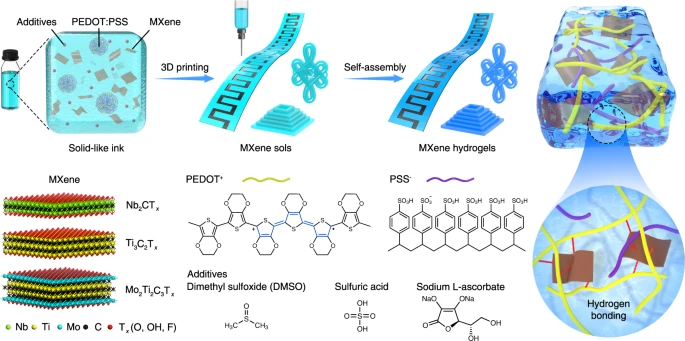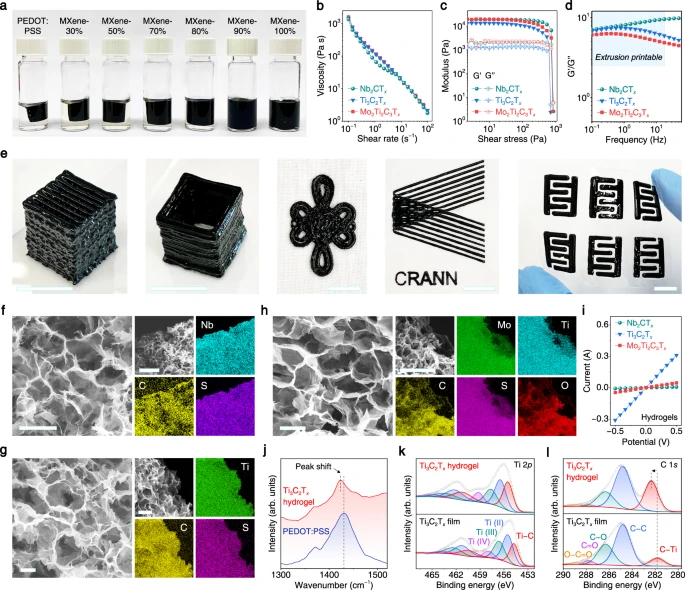Two-dimensional (2D) hydrogels have lately generated significant scientific interest due to their excellent energy storage characteristics. Nevertheless, research on these innovative 2D MXene hydrogels is still in its early stages, restricting their use in large-scale industrial applications.

Study: 4D printing of MXene hydrogels for high-efficiency pseudocapacitive energy storage. Image Credit: RESTOCK images/Shutterstock.com
A recent study published in Nature Communications addresses this problem by offering a generic 4D printing technique for producing MXene hydrogels with adjustable geometries.
MXene Hydrogels for Energy Storage Applications
The recent surge in compact electronics, electric/hybrid automobiles, and periodic energy-generating devices emphasizes the need for effective energy storage technologies.
Supercapacitors (SCs), as prospective options for these applications, have stood out due to their high-power density and extended cyclic stability, enabling quick charging and reducing the requirement for battery maintenance during the equipment's lifespan. However, supercapacitors have a poor energy density, hindering their widespread applicability.
Developing improved electrode materials is one viable option for circumventing this constraint. Conductive hydrogels, especially those based on conducting 2D substances such as MXene and graphene, may be employed as high-energy and power-density electrode components.
MXenes, a two-dimensional material composed of early trivalent carbides and carbonitrides, have appeared as a distinct class of layered-structured metallic materials with appealing characteristics such as metal-like conductivity, augmented ionic absorption, hydrophilic qualities inferred from oxygen-terminated substrates, and mechanical stability.
MXene hydrogels not only have large surfaces and hydrophilic qualities, but they also retain 2D materials' high electric conductance, allowing for electrolytic processes, quick electrolyte ion movement, and electron transport even in thicker electrodes.

Fig. 1. Schematic illustration of 4D printing of MXene hydrogels. The composite inks consisting of MXenes, PEDOT:PSS, and additives (DMSO, H2SO4, and sodium L-ascorbate) are 3D-printed into designed patterns first, followed by a self-assembly process, MXene sols transform into MXene hydrogels. Three kinds of MXenes, Nb2CTx, Ti3C2Tx, and Mo2Ti2C3Tx, are employed for demonstration of the universality and feasibility of this technology.
MXene Hydrogels: Research Gap and Other Challenges
2D MXenes provide a wide number of viable options for creating conducting 2D hydrogels because of their huge surface-area-to-volume ratio, redox-capable interface features, high electric conduction, and structural/chemical diversity. Many MXene hydrogels have already been created with some success employing metal ions or polymers as crosslinkers.
Nonetheless, research on these MXene hydrogels is still in its early stages, and significant obstacles remain. First, earlier studies have only looked at titanium carbide (Ti3C2Tx). No similar reports of other MXene hydrogels are available in the literature.
Secondly, the polymeric crosslinkers used are insulators, reducing the electrical conductance of MXene hydrogels and weakening their electrical and electrolytic effectiveness. Finally, the morphology of these MXene hydrogels is highly dependent on the form and size of castings, making it doubtful that they will match the criteria of accuracy and complexity in many situations, particularly in the context of the fast development of personal electronics.

Fig. 2. Characterizations of MXene inks and hydrogels. a Photographs of Ti3C2Tx hydrogels with different MXene contents prepared by self-assembly. b Viscosity as a function of shear rate for Nb2CTx, Ti3C2Tx and Mo2Ti2C3Tx inks. c Storage modulus (G′) and loss modulus (G′′) as a function of the shear stress for Nb2CTx, Ti3C2Tx and Mo2Ti2C3Tx inks. d Frequency dependency of the ratio of the G′ to G″ for Nb2CTx, Ti3C2Tx and Mo2Ti2C3Tx inks. e Photographs of 4D-printed MXene hydrogel architectures (from left to right): Ti3C2Tx hydrogel microlattice on glass slide, Ti3C2Tx hydrogel rectangular hollow prism on glass slide, Nb2CTx hydrogel Chinese knot on cloth, Nb2CTx hydrogel “CRANN” logo on PET film, flexible Mo2Ti2C3Tx hydrogel MSC units on PET film. All scale bars in e correspond to 1 cm. f SEM and energy-dispersive X-ray spectroscopy (EDX) mapping images of Nb2CTx hydrogel. g SEM and EDX mapping images of Ti3C2Tx hydrogel. h SEM and EDX mapping images of Mo2Ti2C3Tx hydrogel. All scale bars in SEM images in f–h are 5 μm and all scale bars in EDX mapping images in f–h are 20 μm. i I−V curves of Nb2CTx, Ti3C2Tx, and Mo2Ti2C3Tx hydrogels with a size of 10 × 2 × 2 mm. j Raman spectra of pure PEDOT:PSS film and 4D-printed Ti3C2Tx hydrogel. High resolution k Ti 2p and l C 1s XPS spectra of filtered Ti3C2Tx film and 4D-printed Ti3C2Tx hydrogel. Binding energies were all calibrated to the C 1s peak at 284.8 eV.
4D Printing for Scalable Fabrication of MXene Hydrogels
Additive manufacturing, often known as 3D printing, is an effective method for attaining the exact, mold-free, and low-cost creation of complicated structures by a layer-by-layer deposition process. With the arrival of the 4th dimension of time, 4D printing has recently emerged as an interesting technology.
It not only retains all of the advantages of 3D printing but also enables static objects generated by 3D printing to alter their structure, appearance, or usefulness over time when subjected to particular external stimulation, conferring the printed items with new characteristics.
In this study, a novel 4D printing process using a conductive polymeric material as the crosslinker was devised for the large-scale production of MXene hydrogels. Crosslinked MXene hydrogels with increased mechanical properties were achieved with this 4D printing method by adopting a facile heat-stimulated self-assembly procedure compared to the soluble MXene sol patterns generated by conventional 3D printing.

Fig. 3. Electrochemical performance of 4D-printed Ti3C2Tx hydrogel MSCs. a CV curves of 4D-printed Ti3C2Tx hydrogel MSC at scan rates of 2, 5, 10, 20, 50, and 100 mV s−1. b GCD curves of 4D-printed Ti3C2Tx hydrogel MSC at current densities of 1, 2, 3, 5, and 10 mA cm−2. c Comparison of areal capacitance of 4D-printed Ti3C2Tx hydrogel MSC with other printed MSCs. d Ragone plots of 4D-printed Ti3C2Tx hydrogel MSC and other high-performance MSCs. e CV curves of 4D-printed Ti3C2Tx hydrogel MSC at a scan rate of 10 mV s−1 at 25 °C, 0, and −20 °C. Inset is the PVA-EG-H2SO4 gel electrolyte at −20 °C, showing great transparency and flexibility. f Capacitance retention of 4D-printed Ti3C2Tx hydrogel MSC during cooling/heating cycles. g Comparison of areal capacitance of 4D-printed Ti3C2Tx hydrogel MSC (10 mV s−1) with other devices at low temperatures. h Cycling performance of 4D-printed Ti3C2Tx hydrogel MSC at a current density of 30 mA cm−1 at −20 °C, inset shows the EIS data of this MSC before and after 10,000 cycles at −20 °C. i CV curves of single 4D-printed Ti3C2Tx hydrogel MSC, four MSCs in series (4 S), four MSCs in parallel (4 P), and two in series and in parallel (2S2P), at a scan rate of 5 mV s−1. Insert shows the photograph of a 4 S tandem device powering three LED indicators, demonstrating the feasibility of our MSCs for practical applications.
Highlights and Key Developments of the Study
This study's 4D printing approach showed exceptional universality, permitting the creation of various MXene hydrogels. Interestingly, the as-produced MXenes had varying amounts of atomic layers and transitional metals on their surfaces, indicating a broad family of MXenes with various structures and characteristics.
Additionally, the morphologies of the 4D-printable MXene hydrogels could be accurately customized. MXene hydrogels, which have good hydrophilic qualities, large specific surfaces, and high electric conduction, were used to readily build various complicated designs such as micro lattice, rectangular hollow prism, and micro-supercapacitor (MSC) components.
Moreover, the low-temperature functioning of the MXene hydrogel MSCs was achieved, with higher charge retention of 90.6 percent at 0 degrees Celsius and 82.2 percent at -20 degrees Celsius. Based on these results, it is reasonable to infer that this study provides new perspectives into the fabrication of MXene hydrogels and will enhance MXene and conductive hydrogel applications in energy storage, biosensors, water filtration, and other industries.
Reference
Li, K. et al. (2022). 4D printing of MXene hydrogels for high-efficiency pseudocapacitive energy storage. Nature Communications. Available at: https://doi.org/10.1038/s41467-022-34583-0
Disclaimer: The views expressed here are those of the author expressed in their private capacity and do not necessarily represent the views of AZoM.com Limited T/A AZoNetwork the owner and operator of this website. This disclaimer forms part of the Terms and conditions of use of this website.